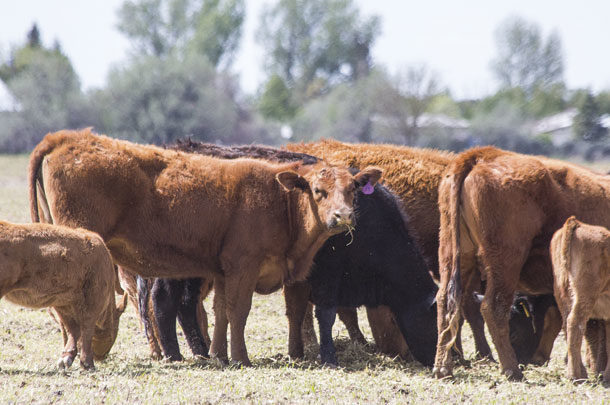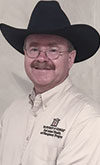Most articles about the value of pregnancy diagnosis focus on identifying the open cow and getting her off the feed bill. With carrying cost being more than $2 per day over the winter, there is a lot of value in that approach. And really, that’s about all many producers expect from their preg check process.
But there is more we can do with preg check information. We can make money with it or at least be more efficient (spend less).
Checking cows for pregnancy is an essential component of reproductive efficiency. But according to the 2007 USDA National Animal Health Monitoring System (NAHMS) study, only about 20% of all operations used palpation or ultrasound to pregnancy test their cows. (The blood test wasn’t available at that time.)
Some cows just don’t breed back for a variety of reasons. However, focusing only on the open cow misses part of the value of the procedure. Using the information to manage the pregnant cows for optimum fertility can pay real dividends in this high calf market.
After preg checking there are two groups of cows: the pregnant cows and the opens. But there are subgroups of those. In the pregnant cows, there are the first-calf heifers, middle-aged cows and aged cows. They can be further divided into cows in adequate body condition and those that are thin. Then there are the early bred cows, cows that will calve in the middle of the season and the late-bred cows. Using this information to manage high-risk groups will improve the health of the calf crop, fertility during the next breeding season, the profitability of future calf crops and longevity of the cows.
Cows that consistently calve early every calving season are our all-stars. They are the ones that often wean the biggest and best calves for market or replacements. The early bred cows and cows that will calve in the middle of the calving season in good body condition score (BCS) (greater than BCS 5) don’t require much management. They just need to be managed to maintain their body condition and calve in a clean environment. More than 80% of cows that calve with a BCS of 5 or 6 and do not lose condition after calving are cycling by 60 days post-partum.
The cows that are in thin body condition need more groceries. There’s plenty of research that shows cows that calve with a BCS of 4 or less may take as much as four months to cycle back after calving and even longer if they lose body condition after calving. That increases her risk of breeding late or not at all and leaving the herd earlier than planned. Managing those thin cows to gain weight during the dry season can shorten the time it takes to cycle and breed back after calving. Depending on cow frame size, mature bodyweight, forage quality and availability, it may take two to three months for a cow to improve 1 body condition score during the dry period on forage alone (1 score equals approximately 80 to 100 pounds).
Supplementing thin cows during the dry period to gain weight is a good investment since it can enhance her chances of breeding back after calving, plus it can improve colostrum quality as well as calf health. If cows are very thin, it might pay to wean their calf early and provide high-quality feed through calving and lactation.
In order to effectively use data to manage cows in the dry period, there are several essential pieces of information required for effective data collection at preg check other than cow ID and pregnancy status: cow body condition (scale of 1 to 9, with 2 being dangerously thin and 9 being obese), weight if scales are available, age, condition of teeth if an aged cow, udder and hoof condition, any injuries, lameness or other signs of external problems like bad eyes, and estimated days pregnant. Blood tests will give you a yes, no and maybe result, but ultrasound and palpation should give you estimated days pregnant.
Tools for the trade
Ultrasound is most useful prior to 120 days of pregnancy to determine fetal age. A trained, experienced palpator can accurately estimate gestational age. The procedure needs to be performed early enough to allow sufficient time to make management changes if needed (usually at least four months before calving). Producers often have it done around the same time as weaning or calf preconditioning.
A couple of advantages of separating pregnant cows into management groups at pregnancy check by BCS and estimated calving period are: Thin cows and first-calf heifers can be fed more intentionally and efficiently, and late cows can be kept separate from the earlier-bred cows. Keeping calving groups in separate pastures helps reduce the contamination of the calving area during calving. Scours typically doesn’t affect the earlier-born calves, but more so the later-born calves. If these cows are already in a separate pasture, they aren’t exposed to the increased pathogen load of a contaminated calving area.
Older cows
Old cows or cows with bad udders, hooves, lame or other problems like bad eyes may need to be culled depending on the severity of their condition. Producers may want to keep them and get that last calf if they are bred early. It may not be practical to calve these cows separately, but having them identified for extra attention at calving time may increase chances of a successful calving.
Managing cows according to BCS and expected calving period will improve fertility, but whether it is practical or not to manage separate cow groups prior to calving depends on available facilities and labor. Reproductive efficiency is the single-most important factor affecting productivity and profitability, and the success of a breeding season is most affected by how cows were managed in the dry period before calving.
Sometimes the preg check results reveal issues with the herd. For example, if a high percentage of cows are bred late in the breeding season, this could mean cows went into the season in poor condition or there was a pathogen like Tritrichomonas foetus in the herd. Ideally, we want most of cows bred during the first 20 to 30 days of the breeding season because those cows are the most productive. If cows aren’t there, we need to find out why and manage accordingly.
What do we do with our open cows? There are several options to optimize income of the open cows. In that group, there are open first-calf heifers, middle-aged and older cows. It might not be the best decision to just sell all the opens, but instead to evaluate them and determine what is the best plan.
Market cows
Aged cows, cows with bad udders or hooves, lame cows, bad eyes, etc. – these cows probably should be sold for slaughter. If they are in thin condition and the resources are available, it might pay to feed them for a while depending on the cost of gain and expected market price. Market cows in moderate-to-good flesh but not too fat usually bring the best price. If there are only a few head, it may be more convenient to sell through a local sale barn or contact an order buyer. If there is a full trailer load, these may be direct marketed to the processing plant. Knowing your options ahead of time and paying attention to the seasonal cull cow market is essential to capturing the best value of your market cows.
Young cows
With prices of bred cows, it might not be a bad idea to keep some of the open first-calf heifers or 3- and 4-year-olds to breed again next year, if she passes a thorough reproductive examination by the veterinarian and no problems are found. Cows in this group sometimes bring little more than a good heifer calf at the sale barn, so selling her as an open may not be the best option. Depending on the need for replacements, keeping her can be a wise economical decision, especially if the cow or heifer weaned a large calf or had some other redeeming trait.
Breeding the open young cows for replacements has a few advantages over breeding heifers. Cows have fewer calving problems than heifers, therefore, require less supervision and assistance at calving. The open cow likely requires less feed since she has already reached or is close to her mature bodyweight.
Another option for the young or middle-aged cow is breeding her back immediately and marketing bred cows depending on the price of bred cows. If the reason she is open is likely nutritional or insufficient bull power, then breeding her back to sell as a bred cow might be a great option. The embryo transfer industry is always looking for high-quality open cows. ![]()

-
Lee Jones
- Associate Professor
- College of Veterinary Medicine
- University of Georgia
- Email Lee Jones












